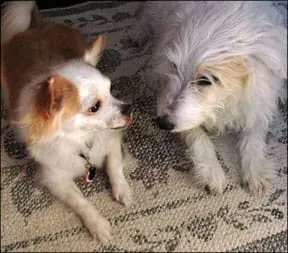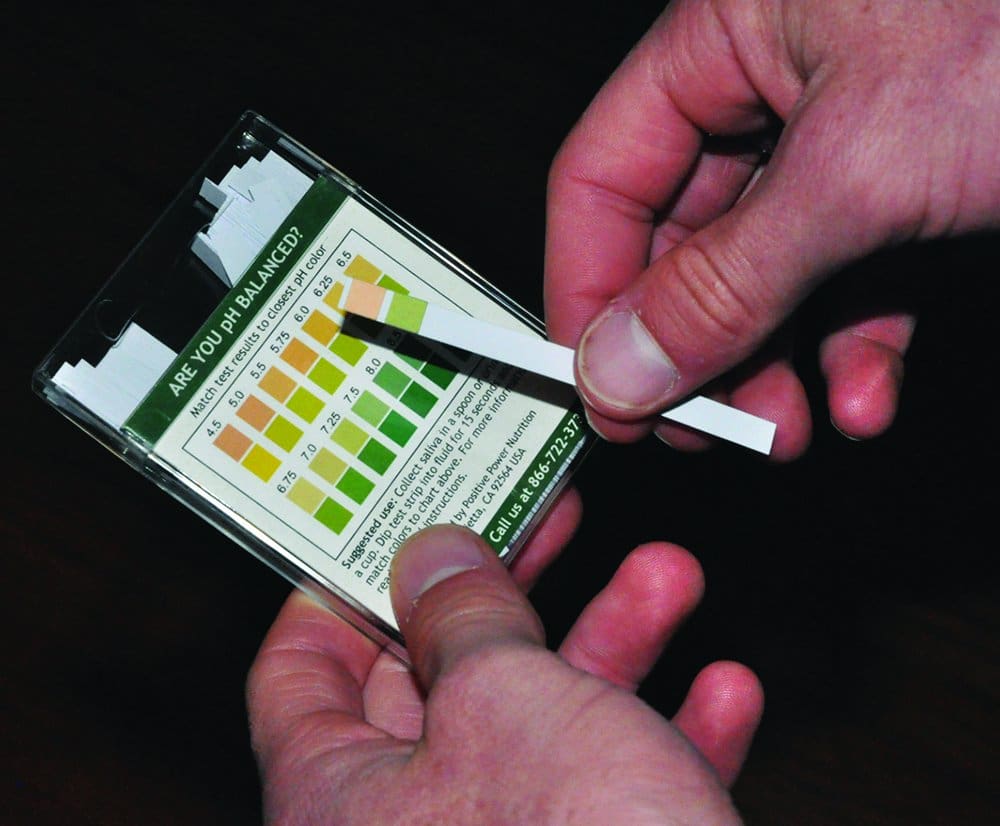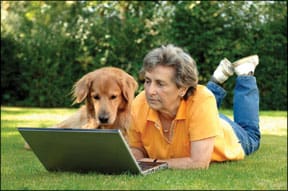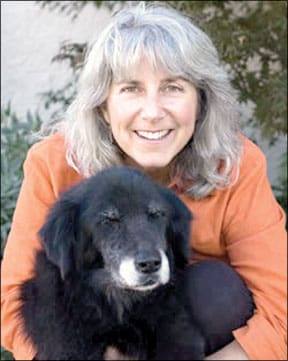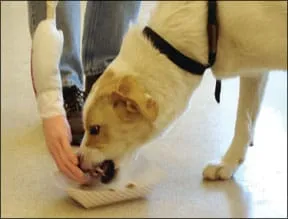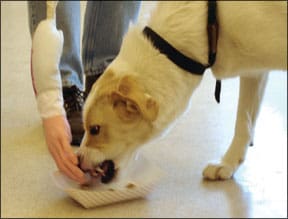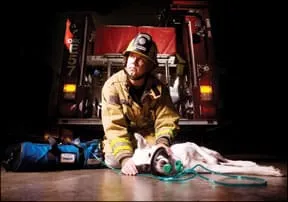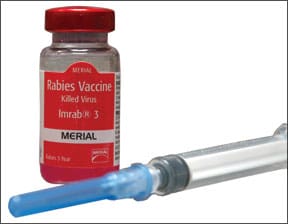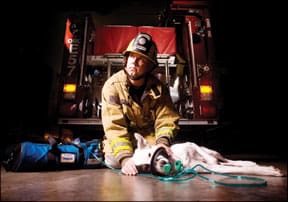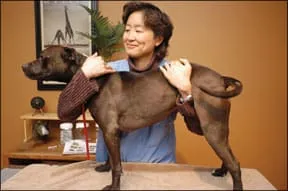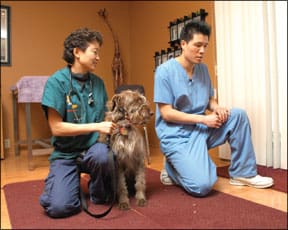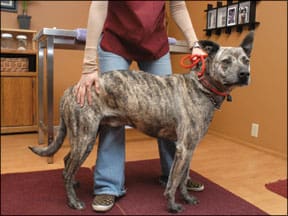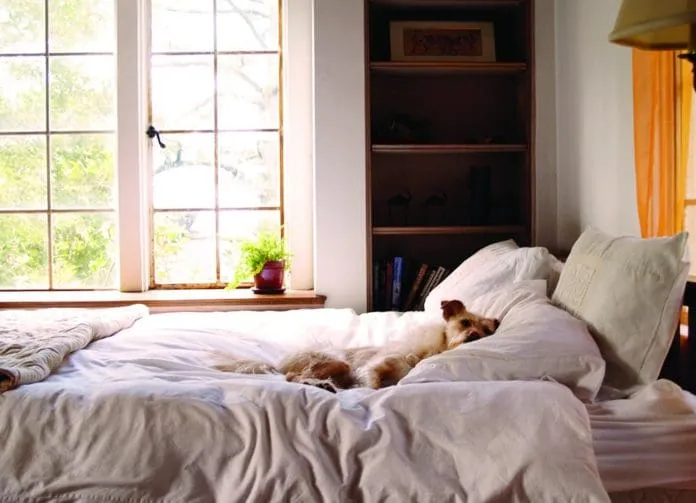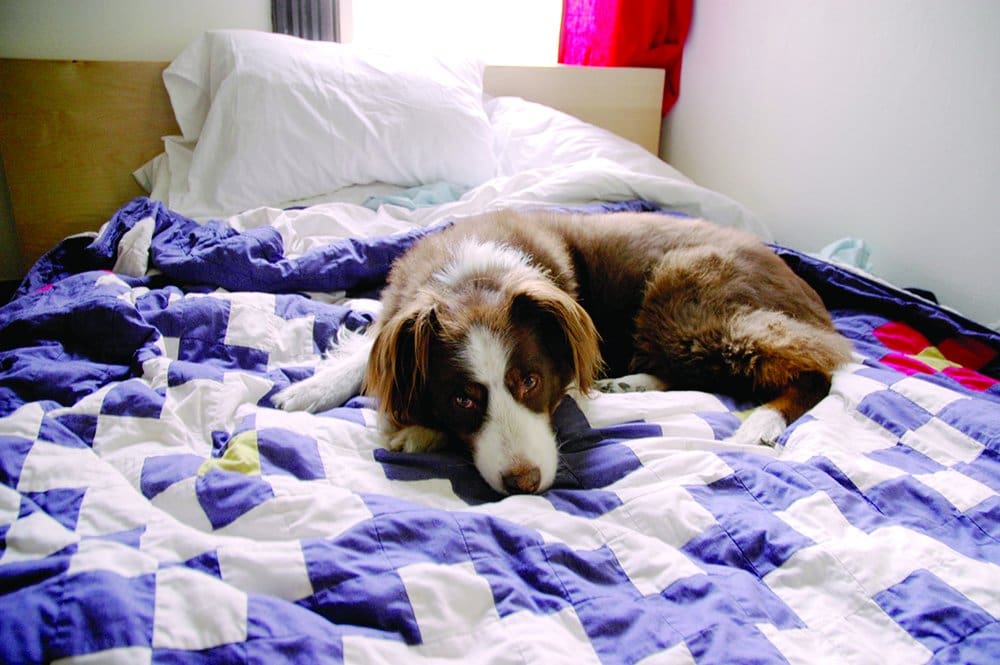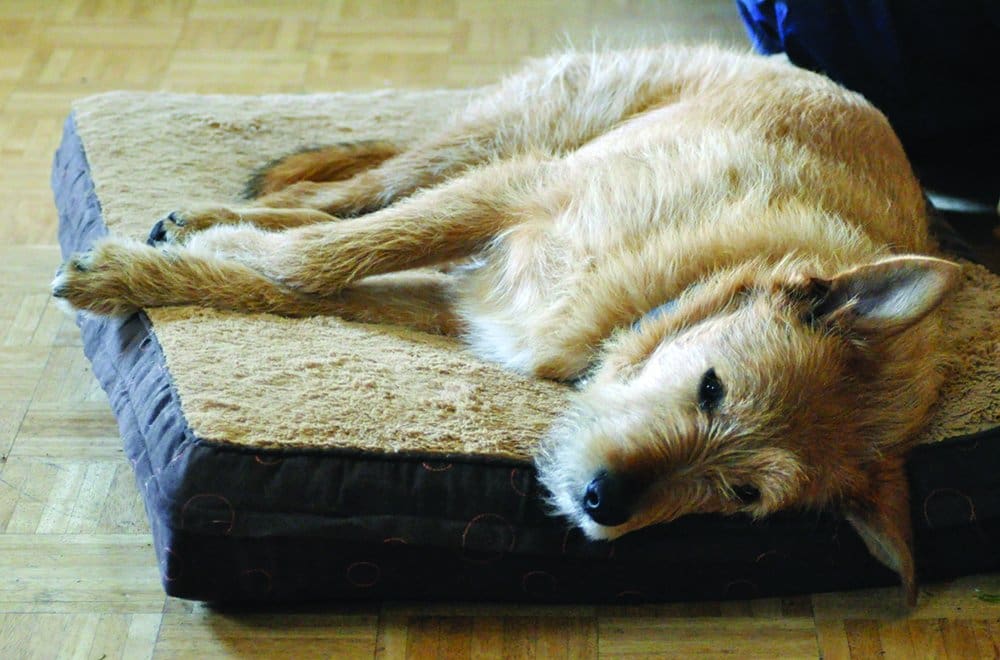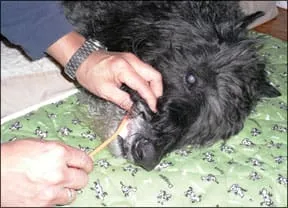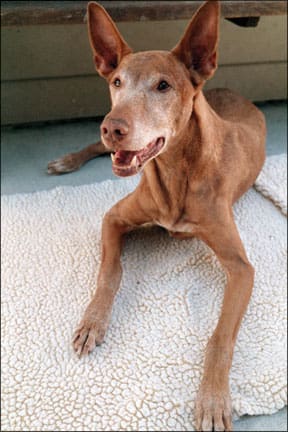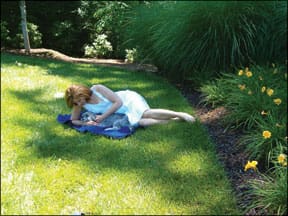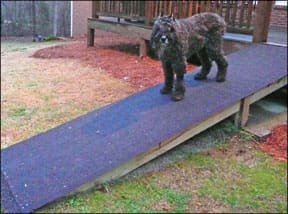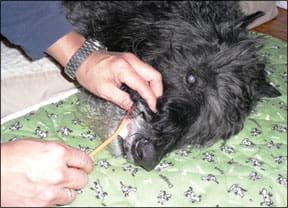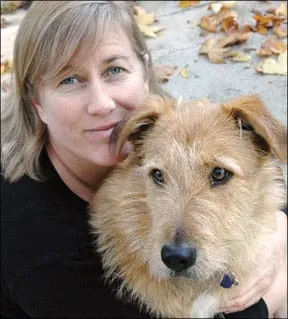Editor’s Note: Twenty years ago, people freely used the term “aggressive dog” to describe what, today, we would call a “dog with aggressive behaviors.” The problem with the term “aggressive dog” is that very few dogs are aggressive all the time – and if they are, they are unlikely to be in anyone’s home. Most dogs who display aggression in some situations are loving and loved dogs in other circumstances; calling them “aggressive dogs” overlooks the fact that they are terrific dogs most of the time. Throughout this article, we may use the older, more familiar term, and we will add the modern term that more accurately describes a dog who sometimes displays aggressive behaviors.
DOGS FIGHTING IN YOUR HOUSEHOLD: WHAT TO DO
- Manage your dogs’ environment so they don’t have the opportunity to antagonize each other.
- Identify your dogs’ stressors and eliminate as many as possible to keep them further below their bite threshold while you modify behavior.
- Seek help from a qualified positive behavior professional if you are in over your head. An aggressive dog (a dog who displays aggression at other dogs) is a serious matter!
Knowledgeable dog people are quite aware that not all dogs get along with each other, despite the fact that canis lupus familiaris (domestic dog) is a social species. Hey, we humans are a social species, and we certainly don’t all get along! Two dogs fighting within the same household is unhappily common in our world. As a professional behavior consultant who works with aggressive dogs (dogs with challenging aggressive behaviors), I probably see more than my fair share of it. By far the most difficult and most distressing presentations of tension between dogs are interdog aggression cases: dogs in the same family who aren’t getting along with each other.

I’ve had a spate of these clients in recent weeks. Even our own Lucy and Missy, a Cardigan Corgi and Australian Shepherd who don’t always get along seamlessly, seem to have experienced an increase in relationship tensions this winter. I can’t give you a tidy explanation as to why, but I’m beginning to put more stock in the explanation jokingly offered by my dog-trainer colleague, Jennifer Swiggart, CPDT-KA, PMCT, when she called it “snow aggression.”
Why Do Dogs Fight?
Why do dogs attack other dogs in the house? Far from a case of dog sibling rivalry, when one dog attacks the other in the house, the reason is stress. With the very rare exception of idiopathic aggression – at one time called “rage syndrome,” “Cocker rage,” or “Springer rage” and grossly over-diagnosed in the 1960s and ’70s – aggression is the result of a stress load that pushes a dog over his bite threshold.
You can compare it to incidents of “road rage” in humans. When you read about the man who pulls out his .38 revolver because someone cut him off on the freeway and blows away the unfortunate offending driver, you can bet there was more going on for him than just a simple traffic violation. This is the guy who was likely laid off his job, lost his retirement investments, had his wife tell him this morning that she was leaving him, and just got notice in the mail that the bank is foreclosing on his home. Getting cut off on the freeway is simply the last straw – the final stressor that pushes him over his “bite threshold.”
So it is for dogs. When tensions increase between Missy and Lucy, I need to look for possible added stressors in their environment that are pushing them closer to, and yes, sometimes over, their bite threshold. From that perspective, “snow aggression” is a real possibility: With recent record snowfalls reaching a total of 50 inches here, the resulting decrease in exercise opportunities, as well as higher stress levels of human family members who aren’t fond of snow (guilty!), can be stressors for the canine family members.
To resolve aggression issues between your own dogs, you’ll want to identify not only the immediate trigger for the aggression – fighting over a meaty bone, for example – but also everything in your dog’s life that may be stressful to him. The more stressors you can remove from his world, the less likely it is that he will use his teeth – the canine equivalent of pulling out a .38 revolver.
Common Stressors for Dogs
Stress in dogs can happen anytime and be anywhere. Remember that it’s the sum total of a dog’s stress that pushes him over his bite threshold, so the more of his stressors you can identify and get rid of, the more you’ll ease tensions between your canine family members.
When I sit down with a client for an interdog aggression consult we create a list of all the stressors we can think of for the dogs in question.
After identifying stressors, we discuss possible strategies, assigning one or more strategies to each of the listed stressors. These strategies are:
– Change the dog’s opinion of the stressor through the use of counter-conditioning and desensitization.
– Teach the dog a new behavioral response using operant conditioning.
– Manage the dog’s environment to minimize exposure to the stressor.
– Get rid of the stressor.
– Live with it (most appropriate for low-level stressors). Next, I help the client make a management plan that will go into place immediately, to help defuse the tension until she is able to start work on behavior modification. Then we create action plans for two or three of the stressors on the list, starting with the one the client is most concerned about – in this case, the dog-on-dog aggression.
Here is a sample list of stressors we’ve put together:
| STRESSOR | STRATEGY |
| The other dog | Change the aggressive dog’s opinion of the stressor through the use of counter-conditioning and desensitization (CC&D). |
| Passers-by outside the living room window | Change dog’s opinion of the stressor through CC&D; manage dog’s environment to minimize exposure to the stressor (i.e. close blinds, close off dog’s access to that window) |
| Threats to resources (food/toys) | Change dog’s opinion of the stressor through CC&D; use operant conditioning to teach dog a new behavioral response |
| Doorbell ringing | Change dog’s opinion of the stressor through CC&D; use operant conditioning to teach dog a new behavioral response |
| Car rides | Change dog’s opinion of the stressor through CC&D; live with it (most appropriate for low-level stressors) |
| Trips to the vet | Change dog’s opinion of the stressor through CC&D; live with it (most appropriate for low-level stressors) |
| Nail trimming | Change dog’s opinion of the stressor through CC&D; use operant conditioning to teach dog a new behavioral response; teach dog to scrape his nails on an abrasive surface |
| Thunder | Change dog’s opinion of the stressor through CC&D; manage dog’s environment to minimize exposure to the stressor; live with it (most appropriate for low-level stressors); possible use of an appropriate anti-anxiety medication |
| Fireworks | Change dog’s opinion of the stressor through CC&D; manage dog’s environment to minimize exposure to the stressor; live with it (most appropriate for low-level stressors); possible use of an appropriate anti-anxiety medication |
| Arthritis | Manage dog’s environment to minimize exposure to the stressor; ask your vet whether pain-reducing medication is appropriate |
| Recurring ear infections | Get rid of the stressor: explore medical treatment and your dog’s diet (ear infections can result from dietary allergies) |
| Underground shock fence | Get rid of the stressor |
| Prong collar | Get rid of the stressor |
| Use of physical and harsh verbal punishments | Get rid of the stressor |
| Owner’s stress | Manage dog’s environment to minimize exposure to the stressor; get rid of the stressor |
There are many other possibilities. My clients usually list 10 and 20 identified stressors. Be sure to include things that may cause even mild stress. The more stressors you can eliminate, the better.
Food Aggression in Dogs and Other Stress Triggers
It’s often relatively easy to identify the immediate trigger for your dogs’ mutual aggression. It’s usually whatever happened just before the appearance of the hard stare, posturing, growls, and sometimes the actual fight.
Tension over resources is a common trigger. Dog #1 is lying on his bed, happily chewing his deer antler, when Dog #2 approaches. Dog #1 tenses, signaling to #2 Dog, “This is mine and I’m not sharing.”
In the best of worlds, #2 defers by looking away, saying in canine speak, “Oh sorry, no worries, I was just passing through.” When things go wrong, however, a fight breaks out. Dog #2’s approach was the trigger for #1, even if #2 had no interest in the chew item. Perhaps Dog #2 failed to notice or failed to heed #1’s warning. Remember that resources include more than just food; a guardable resource can also be a high-value human, a coveted spot on the sofa, or access to a doorway. The stressor in these cases is obvious: the dog is anxious over the possibility of losing or having to share his treasured possession.
Other triggers may be less obvious. If a dog is in pain, but not showing it, the mere proximity of a packmate who has inadvertently bumped her in the past could be a trigger. Dogs can be notoriously stoic about pain, especially slowly developing arthritis, or unilateral pain (where you may not see a limp). The undiagnosed arthritic dog may become defensively aggressive in anticipation of being hurt by a livelier canine pal, trying to forestall painful contact in what looks to the owner like “unprovoked” aggression.
“ Social aggression” can result when neither of two dogs in the same family is willing to defer to the other. Note that this type of aggression is about deference (or lack thereof) not dominance. In behavior science, “dominance” is simply about access to a mutually desired resource. The dog who gains access in one encounter is dominant *in that encounter*. In the next encounter, the other dog might gain access to the resource and be dominant in *that* encounter. When you have identified your dogs’ triggers, you can manage their environment to reduce trigger incidents and minimize outright conflict. This is critically important to a successful modification program. The more often the dogs fight, the more tension there is between them; the more practiced they become at the undesirable behaviors, the better they get at fighting and the harder it will be to make it go away. And this is to say nothing of the increased likelihood that sooner or later someone – dog or human – will be badly injured.
How to Stop Dogs From Fighting
Dog Aggression Counter-Conditioning
My first choice with most clients is the first strategy listed above: changing the dogs’ opinion of each other through counter-conditioning and desensitization (CC&D).
CC&D for intra-pack aggression involves changing your dogs’ association with each other from negative to positive. The easiest way to give most dogs a positive association is with very high-value, really yummy treats. I like to use chicken – thawed out pre-cooked frozen chicken strips (no breading or spices) canned, baked, or boiled, since most dogs love chicken and it’s a low-fat, low-calorie food.
Counter-Conditioning Your Dogs to Get Along:
a)Determine the distance at which your dogs can be in each other’s presence and be alert or cautious but not fearful or aroused. This is called the threshold distance. If one dog has a greater threshold hold distance than the other (often the case), work at the greater distance.
b)With you holding Dog A on a leash, have your helper appear with Dog B at threshold distance “X.” The instant your dog sees the other, start feeding bits of chicken, non-stop. Your helper will feed chicken to her dog, too, the instant he notices your dog.
c)After several seconds, have the helper step out of sight with Dog B, and you both stop feeding the chicken.
d)Keep repeating steps 1-3 until the sight of the other dog at distance “X” consistently causes both dogs to look at their handlers with a happy smile and a “Yay! Where’s my chicken?” expression. This is the physical presentation of the dogs’ conditioned emotional response (CER); each dog’s association with the other at threshold distance “X” is now positive, so they can deliberately look at you to get their chicken, rather than staying intensely focused on each other.
e)Now you need to increase the intensity of the stimulus by increasing the length of time Dog B stays in sight. Continue to feed chicken when they are in view of each, occasionally pausing to let them look at each other again, and immediately feeding chicken when they do.
f)When length of time seems to make no difference to either dog – you’re getting a consistent “Yay, where’s my chicken?” response regardless of how long Dog B stays in view, increase the intensity again, this time by increasing Dog B’s movement. Have the handler walk back and forth with her dog, still at distance “X,” slowly at first, then with more energy, even adding in some other behaviors such as sit, down, and roll over.
g)Now you’re ready to start decreasing distance by moving Dog A a little closer to the location where the Dog B will appear. When you obtain consistent CERs from both dogs at each new distance you can decrease the distance a little more, until both dogs are happy to be very near each other.
h)Then return to your original threshold distance and increase intensity stimulus by having Dog B move around more and more, as you gradually decrease distance and obtain CERs from both dogs along the way, until they are delighted to be near each other.
i)Now go back to your starting distance and increase intensity again, by having both dogs move more naturally as the distance decreases, offering CERs at each new distance before you come any closer, until they can be within six feet of each other, moving around, still relaxed and happy about chicken.
j)Finally, find ways for your dogs to engage separately in mutually enjoyable activities together. If they both enjoy car rides, take them for a drive, but be sure they are seat-belted or crated far enough apart to avoid any tension. If they love hiking, take them on “parallel” walks, one with you, one with your training partner, with humans between them at first, and eventually with dogs between humans when you’re sure their emotions are appropriate. Parallel swims, for dogs who love the water, can work well too.
When you feel the dogs are ready to finally interact with each other again, be careful not to undo all your hard work. You might first let them greet through a barrier, such as a baby gate or exercise pen.
It’s useful to desensitize both dogs to a muzzle over the period you’re desensitizing them to each other (in separate sessions), so the first time you’re ready for them to actually interact together you can muzzle them and be confident they can’t hurt each other.
The more intense the relationship between the two dogs, the more challenging it is to modify their behavior. The more negative interactions they’ve had, the more injuries, the longer the tension has been going on, and the stronger their emotions, the longer it will take to reprogram their responses to each other. If they were good friends at one time, it’s likely to be easier than if your dogs have always tried to fight each other.
Remember to seek the help of a qualified positive behavior professional if you don’t feel competent and confident about working with your dogs on your own.
Operant Strategies to Combat Dog Fights
The second option is to teach your dogs a new operant behavior in response to each other, using the “Constructional Aggression Treatment” (CAT) procedure developed by Dr. Jesus Rosales-Ruiz and Kellie Snider at the University of North Texas. (See “Modifying Aggressive Behavior,” and “Constructional Aggression Treatment“.)
In daily life, dogs learn to offer aggressive “distance-increasing” signals in order to make other dogs go away. Every time this works, the “go away” behavior is reinforced. The CAT procedure teaches the dog that calm behavior can make the other dog go away, and as a result, the aggressive dog can ultimately become friendly and happy about the other dog’s presence.
A variation on the operant approach is the “Behavioral Adjustment Training” procedure (BAT) created by Oregon trainer Grisha Stewart, MA, CPDT-KA, CPT. BAT is similar to CAT, but uses a variety of environmental reinforcers rather than the location and movement of the other dog exclusively.
As in CAT, the BAT procedure reinforces behaviors other than aggression in the presence of the other dog. In this case, however, your repertoire of reinforcers is larger, including the use of food reinforcers and having the “subject” dog (the aggressive one) move away instead of the other dog.
If one or both of the dogs are ready to do battle on sight, they must be strictly managed and kept separate from each other except when you’re doing your controlled modification procedure with them. If the aggression is more predictable and situational, the dogs can be together as long as you can manage and prevent the trigger(s) from causing conflict.
Stress Trigger Management for Aggressive Dogs (Dogs Who Display Aggressive Behavior)
What does it mean to “manage your dogs’ environment to minimize exposure to his stressors”? Simply put, it means making changes to your dog’s environment in order to keep your dogs away from the stimuli that stress them.
If the dogs are stressed by each other, of course, the first task is to keep them separated, through the assiduous use of doors, fences, baby gates, crates, and tethers. Smart positioning can help; locate each dog’s crates or tethering area out of the other dog’s sightline. Take them outdoors to potty separately, and separate them well before feeding time, to reduce tensions that arise when everyone is jostling to be fed first.
Next, try to minimize your dogs’ exposure to other stressful stimuli. For example: Say one of your dogs goes over threshold when she sees the mailman approaching your house through the living room window, and her barking display of aggression seems to agitate your other dog. Installing shutters on the window might work (to block your dogs’ view), but closing the door to the front room (to keep the dogs as far away from the sight and sound of the mailman) would be even better. Or you could move your mailbox to toward the sidewalk, instead of next to the front door – the farther from the house, the better. Or get a post office box and do away with the mail carrier altogether. Be creative!
More Management Tools: Stress-Reducing Strategies for Dogs
There are a host of other things you can do to lower general stress in your dogs’ environment.
Exercise can be immensely helpful in minimizing overall tension. Physical activity uses up excess energy that might otherwise feed your dogs’ aggressive behaviors, (a tired dog is a well-behaved dog – and a happy owner!). Exercise also causes your dog’s body to release various chemicals, including endorphins and norepinephrine, helping to generate a feeling of well-being; an exercised dog is a happy dog! Happy dogs are simply less likely to fight.
Even the food you feed your dog can have an impact on his behavior. Poor quality protein can interfere with a dog’s ability to make use of the serotonin that occurs naturally in his system. Serotonin is a neurotransmitter that helps regulate mood and sleep, and also affects memory and learning. Foods containing high-quality protein can contribute to your dogs’ behavioral health and physical health.
Basic training enables you and your dog to communicate more easily with each other (which is less stressful for both of you), and helps your dog understand how his world works, which reduces his stress. A good training program emphasizes structure and consistency, both of which make a dog’s world more predictable. Predictability equals less stress; unpredictability is stressful.
If you’ve ever had a massage, you know how calming touch can be. Dogs aren’t that different from us; you can calm and soothe your dog with physical touch, both through canine massage and TTouch. Combine your calming touch sessions with aromatherapy, by using a therapeutic-quality lavender essential oil in an electric nebulizing diffuser in the room while you massage your dog. Then you can build your dog’s “ahhh” association with the lavender scent to help him be calm in more stressful environments, by putting a few drops of essential oil on a bandana that you tie around his neck or on the bedding in his crate.
Other environmental stress reducers include: Adaptil (also known as Comfort Zone, Dog Appeasing Pheromone, or DAP). This is a synthetic substance that is reputedly mimics the pheromones emitted by a mother dog when she’s nursing puppies. Available through pet supply stores and catalogs.
– Through a Dog’s Ear. This set of audio CDs consists of bio-acoustically engineered soothing classical piano music, which has been shown to reduce dogs’ heart rates.
– Anxiety Wrap. This product helps dogs (and cats) overcome their fears and anxieties using the gentle technique of “maintained pressure” – similar to the effect of swaddling for a human infant.
Remove Your Dog’s Stress Triggers
Sometimes you’re lucky: it’s easy to either get rid of your dogs’ stressors or just live with them. Stressors you could get rid of easily include choke, prong, or shock collars (even those used for electronic containment systems); physical or harsh verbal corrections (punishment), and treatable medical conditions. Without these present in their environment, the dogs’ stress level will decrease.
We all have some stress in our lives, and it’s pretty near impossible to get rid of all of it. Just because you’ve identified a stressor for your dog doesn’t mean you have to make it go away. You probably don’t have enough time in your schedule to address every single thing on your list. As you look at your dogs’ list of stressors, the ones they can probably live with are those that don’t happen frequently, that cause only a mild stress response, and don’t appear to escalate over time. You can also refrain from eliminating your dog’s “fun” stressors, such as squirrel-chasing sessions. If you make your way through the rest of your list and still have time on your hands, you can always address the “live with it” items later.
Veterinary Checkup Required
A complete medical work-up, including a full thyroid panel, is indicated for any significant behavior problem, especially aggression.
Any medical condition that causes your dog to behave out of sorts is a massive contributor to stress. Trying to modify aggression while your dog suffers from an untreated medical condition is akin to pushing a behavioral boulder uphill.
You must rule out or identify and treat any medical contributors to your dogs’ behavior in order for your dogs to fully benefit from your modification efforts.
Last Resorts for Training Aggressive Dogs (Dogs Who Display Aggressive Behavior)
Dog-on-dog aggression in the home can feel overwhelming. In fact, it can be dangerous if fights erupt regularly and you try to intervene. Many times a caretaker has been bitten trying to break up fights between her own dogs. The stress that the constant tension generates can damage the quality of your own life, as well as your dogs’ lives.
When a situation feels beyond your ability to cope, your first best option is to find a qualified positive behavior consultant in your area who can help you implement appropriate management and modification procedures, to keep everyone safe and to start making change happen in your dogs’ mutual relationships.
A consultation with a veterinarian who is well-educated in behavior or even a veterinary behaviorist should also be on your list, not only for that all-important medical workup, but also for the consideration of psychotropic behavior modification drugs, if and when appropriate, to help your dog’s brain be more receptive to your modification efforts.
If you feel you’re done your best and peace isn’t in the cards for your pack, it’s okay to admit that some dogs will never get along, and you have had the misfortune to adopt two who don’t. If that’s the case, your options are:
– A lifetime (not just a temporary measure) of scrupulous management
– Rehoming one of the dogs
– Euthanasia
Some trainers say, “Management always fails.” In truth, management does have a high risk of failure, perhaps with potentially dire consequences. The risk is even higher if there are children in the home – not only because they’re more likely to forget to close doors and latch gates, but also because they are at greater risk of injury themselves if they are in the vicinity when a fight happens. Still, I know of several dog owners who have successfully implemented lifetime management protocols for dogs who didn’t get along, and felt that their own quality of life, as well as that of their dogs, was above reproach.
Rehoming can be a reasonable option, especially if the dog being considered for placement has no other significant inappropriate behaviors, and if he can be rehomed to an “only dog” home, or one with dogs he’s known to get along well with. Of course, it can be challenging to find an experienced, appropriate home for a dog with a known aggression behavior challenge, but it may be possible, particularly if he’s an otherwise wonderful companion.
No one wants to think of euthanizing an otherwise healthy member of their canine family. Still, if you’ve done all you can reasonably do given the limits of your abilities and resources, and you’ve not been able to create a safe environment for your family and one of the dogs can’t be rehomed, then euthanasia is not an inappropriate decision. It will be terribly painful for you, and you may always feel guilt and regret about not finding the solution to the problem, although perhaps not as much guilt and regret as you would if one of your dogs badly injured or killed the other, or worse, a person. There is a wonderful Facebook support group called “Losing Lulu” for people who have had to make the impossibly difficult “behavioral euthanasia” decision. If you are one of these, it’s worth checking out.
It’s now 43 degrees outside, and for the first time in many weeks the snow has melted enough I can actually take my dogs for a long hike around the farm. I’d best finish this sentence, turn off my computer, and take our dogs out to stretch their legs so we can all enjoy a very peaceful, aggression-free evening.


